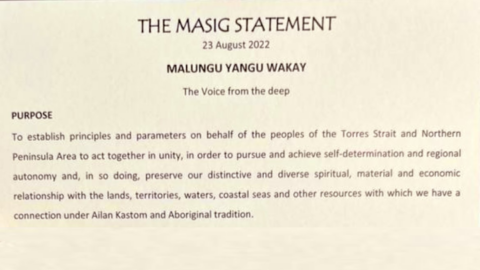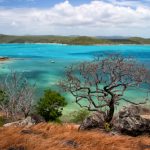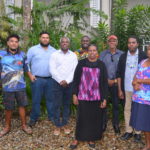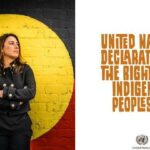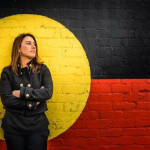Torres Strait Masig Statement Calls for Regional Autonomy by 2037

The people of the Torres Strait Islands came together on Tuesday to release The Masig Statement: Malungu Yangu Wakay – Voice from the Deep.
The release of the document came a week after prime minister Anthony Albanese and Indigenous affairs minister Linda Burney visited the region.
Designed to act in a similar manner to the Uluru Statement from the Heart, The Masig Statement outlines that Torres Strait Islander communities want to “achieve self-determination and regional autonomy” by 2037.
As Torres Strait Island Regional Council mayor Phillemon Mosby explained on the day, the statement is not calling for the region to entirely break away from Australia, but it is proposing a greater degree of autonomy for the people of the strait and the Northern Peninsula Area of mainland Australia.
Both these regions currently fall under the jurisdiction of Queensland. But since 1994, the Torres Strait Islands have been administered by the Torres Strait Regional Authority, which is an Australian government body made up of 20 Torres Strait Islander or Aboriginal people living in the region.
“The beginning of a new beginning”
Calls for greater autonomy in the Torres Strait are not new. The First Torres Strait Islander Councillor Conference held in Masig-Yorke Island in 1937, 85 years ago last Tuesday, saw representatives asserting self-determination and autonomy as their aim.
The Masig Statement seeks to achieve regional autonomy for the Torres Strait and the Northern Peninsula, recognising “the distinct and diverse spiritual, material and economic relationship with the lands, territories, waters, costal seas and other resources” the local peoples have.
The statement sets out four points on how regional autonomy is to be achieved and it invokes the United Nations Declaration of the Rights of Indigenous Peoples and the preamble from the Human Rights Act 2019 (Qld) in doing so.
The points include achieving self-determination, exercising the sovereign right to freely determine political status, to pursue economic social and cultural development, and establishing the right to self-government on internal and local affairs, along with “financing their autonomous functions”.
The final point sets out that the Torres Strait people will be establishing partnerships with the Queensland and Australian governments to facilitate the proposal, and the statement determines that regional sovereignty will begin on 23 August 2037.
Climate crisis
At a press conference on Tuesday, a journalist asked Albanese what he thought of The Masig Statement, as she suggested that the document is “essentially asking for the right to break away as a state or territory”.
The PM responded, “They are very much a valued part of our nation of Australia.” And he added that his visit to the region the week prior had led him to believe the Torres Strait Islander representatives support the proposed Voice to Parliament, as well as recognition in the Constitution.
The low-lying Torres Strait Islands are currently suffering the same fate as Pacific Island nations that are slowly being engulfed by the ocean due to the rising effects of the climate crisis.
Indeed, a group of locals known as the Torres Strait Eight have a complaint lodged with the UN Human Rights Council, calling out the Australian government for its climate inaction, which is resulting in the loss of land, extreme weather events and a substantial downturn in the economy.
